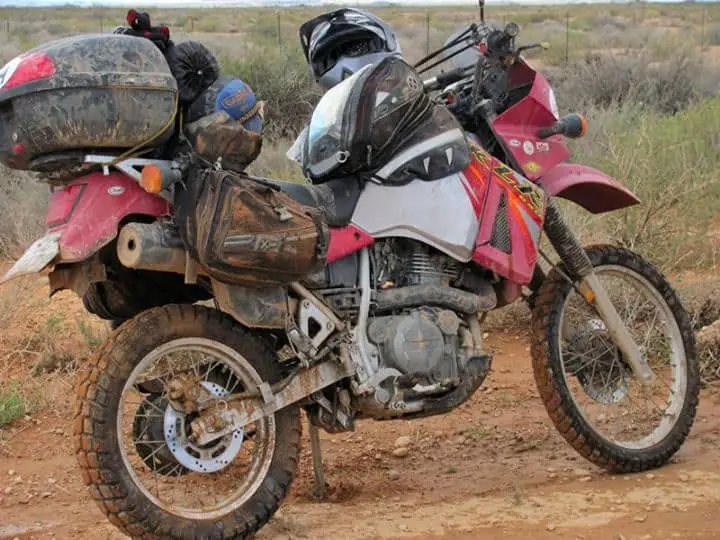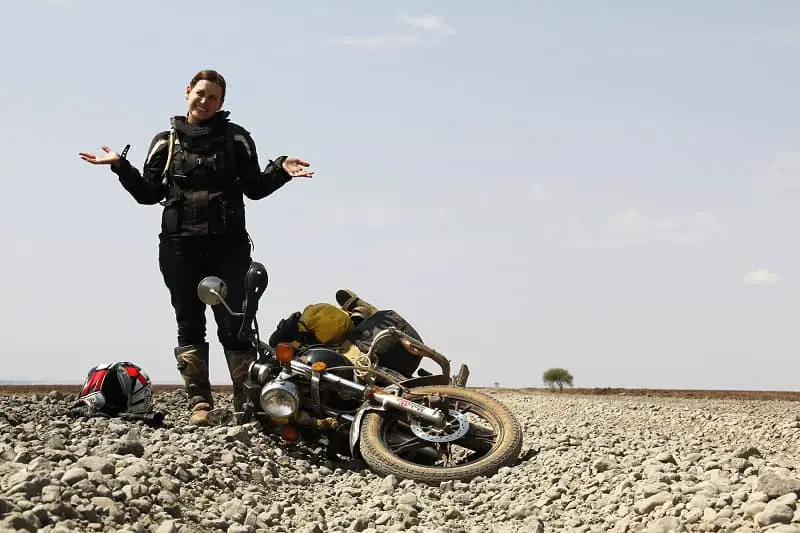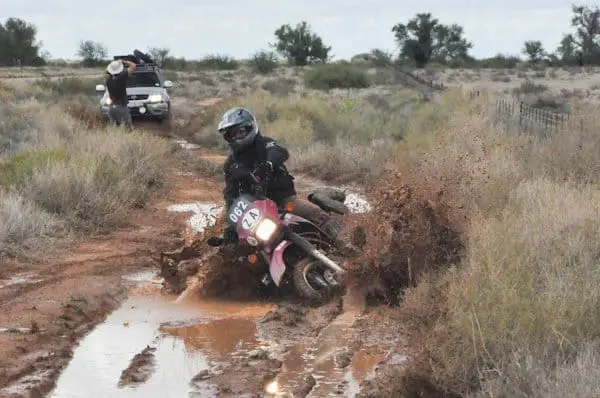I remember riding through the desert with a group of riders and the one guy crashed his BMW R 1200 GS going through a ditch. Luckily he wasn’t hurt but after his bike fell over, it would not start again. There are various reasons why a motorcycle that fell over won’t start.
If a bike won’t start after it fell over, it is usually due to a tip-over sensor or a flooded carburetor. Reset the sensor by switching the ignition off and back on, and let the bike stand until the fuel has drained and evaporated. In some cases oil may have entered the air filter housing or the combustion chamber.
If you’re reading this, you likely dropped your bike and now it won’t start. Don’t panic and don’t beat yourself up. This happens more often than you think, even to experienced riders. Take a deep breath and read on to find out how to get your bike running again.
Why Won’t My Bike Start After it Fell Over?
There are many reasons why a fallen bike won’t start. Take your time to assess the situation and don’t rush getting it fired up again. Let’s have a look at what the issue might be.
No sound when pressing the starter
Some modern bikes have a lean sensor or tip-over switch. If it senses that the bike is on its side, it cuts power to the ignition. If there is no sound at all when pressing the starter button, this may be your issue and the sensor needs to be reset.
On most bikes, this is done by simply switching off the ignition (with the key) and turning it back on. On some bikes you have to repeat this a couple of times. This was the problem with the GS rider I wrote about in the intro. After resetting the sensor, his bike fired up right away.
If this doesn’t work, you may have damaged the kick-stand cut-out switch. On many bikes, you cannot start the engine with the kick stand out. If this switch or its wiring gets damaged, there won’t be any power to the ignition. This happened to my wife’s BMW 650 Funduro at a gas station in Namibia. Luckily I thought about it and disconnected the kick-stand switch.
Another culprit may be the clutch cut-out switch. On my old Kawasaki KLR 650, the engine would not start if you don’t pull in the clutch. This embarrassingly failed on me while attending a BMW GS rider training course. Being the only non-BMW bike on the day, I didn’t get much sympathy. A quick by-pass of the switch (which I made permanent) solved the problem.

If neither of the above brings power back to the ignition and your bike fell over to the right, check the kill switch wiring (Is the kill switch even on? Now that we think about it!). If you still have nothing, you may need to go to the bike shop.
For a comprehensive post on how to diagnose a no spark condition, read this detailed post on how to fix it after you’re done with this one.
Engine turns over, but won’t start
Okay, so there is power at the ignition and the engine turns over, but your bike just won’t start or stay running. It is very likely that you have flooded the carburetor. This is due to the bike lying on its side and fuel freely flowing out of the tank and into the carburetor. In rare cases, the float could also be stuck at the bottom, therefore not closing the float needle and overfilling the reservoir.

The opposite could also have happened. The carb drained and the system is now starved of fuel. If the bike lay on its side for long enough, or the engine was not killed immediately, oil could have entered the air filter housing. If the air filter is clogged, the engine might not get enough air to ignite.
Another rare possibility is an exhaust that was pinched shut from the impact. You should notice this if your exhaust is visibly damaged from the outside.
Engine turns over, then suddenly stops
If you were so rattled that you left your motorcycle’s engine running for long enough while on its side, enough oil could have seeped into the air box and got sucked into the combustion chamber. This will foul the spark plugs, which may prevent the engine from starting. There might also be too much oil in the cylinders for it to ignite.
If you suspect this is the case (you can check the air filter to see if it is dry), don’t do anything until you’ve followed the steps under the next heading. If there is enough oil in the cylinder it may cause serious damage due to something called hydro lock.
Oil is not compressible and if the combustion chamber is filled with oil, the piston won’t be able to rotate through the compression stroke without either stalling (coming to a stop) or causing serious damage (breaking piston rings or bending connecting rods).
How to Get a Bike Running Again After it Has Fallen Over
We’ve already discussed what to do if there is no power to the ignition. In this section, we’ll have a look at how to get a bike running again if the engine is cranking over, but it won’t fire up or stay running.
Flooded engine
On a bike with a carburetor, it is very common for the engine to flood after a tumble. There is too much fuel in the carburetor float bowl or in one of the cylinders. This can usually be fixed by waiting a while and trying again. You can also try to start the engine with the throttle wide open, to allow maximum airflow into the engine.
Don’t hold the starter button in for longer 7 seconds at a time, otherwise you may burn out the starter motor. Let it rest for at least 30 seconds between each try. This might drain the battery if it is not fully charged and in good condition.
If this doesn’t work after a few tries, rather stop and do some more digging. Remove the spark plugs and check whether the tips are wet. If there’s fuel in the combustion chamber, rotate the engine by hand (or by pushing the bike in second gear) until the piston is at the bottom. Leave the bike for an hour or two with the plugs out until the fuel has evaporated.
To make sure that there’s spark at the plugs, earth the spark plug to the engine (by holding the tip against a bare metal part) and press the starter briefly. If there is a blue spark at each plug, your ignition is not the problem.
After the fuel has evaporated and you’ve confirmed that there is spark, it should fire up after cranking for a few seconds.
Oil in the combustion chamber
If you let the engine run while the bike lay on its side, oil could have made its way into the air box through the PCV valve. If enough oil entered the air filter housing, some of it could have been sucked into the intake and into the combustion chamber.
You’ll notice this if your spark plug tips are wet with oil. Also remove your air filter to check for oil in the air box. If you find oil on the plugs and in the air box, you may need to drain excess oil from the cylinder. You can also confirm this by sticking in a plastic straw through the plug hole to check whether it is oily at the tip.
Rotate the engine by hand (or by pushing the bike) with the spark plugs removed so the oil can seep out. You can also try the nozzle of a spray bottle to suck out the oil. Make sure to clean the air filter (constricted airflow may be the cause of your problems) and wipe out any oil.
Once all the oil is out, spray a small amount (2 seconds max) of WD-40 into the cylinder to clean it and rotate the engine a couple of times to remove the excess. Replace the spark plugs and the clean air filter, and try again.
How to Avoid Dropping the Bike in the First Place
Most new riders will drop their bike at least once, so don’t be too hard on your self if this happens. Always make sure you stop somewhere where you can safely put your feet on level ground. If you need to move your bike at walking pace, or turn it around, rather get off the bike and push it while walking next to it.

Most bikes are very well balanced around the midpoint, so don’t lean it over too far. When you put your bike on the side stand, make sure it is all the way out.
The first thing you need to do when your bike tips over while the engine is running is to flip the kill switch.
Pause for a moment. Make sure you are not injured and then pick up your bike as soon as possible. Don’t be shy to ask for help from by-standers and remember to laugh at yourself. Getting angry will only make matters worse!
How to Pick up a Fallen Bike
It is worth it to lay your bike down somewhere where it won’t damage and then practice picking it up on your own. You never know when you might need this skill. To see the correct way to pick up a fallen bike, check out the video below:
Before attempting to pick up your motorcycle, make sure about the following:
- The kill switch is in the off position
- The bike is in first gear (so it doesn’t roll away)
- The side stand is out if it lay on its right-hand side (to catch it when it comes upright toward the left)
Conclusion
I hope this article helped you get your bike started again. If it smokes for a few miles don’t stress. This is due to it burning off excess fuel or oil that entered the cylinders. If it runs rough, make sure the spark plugs are not fouled up.
If you found this post helpful, why not BUY ME A COFFEE? I’d really appreciate it 🙂 Cheers!
Happy riding and stay upright!
Make Sure You are Protected
Beginner riders often skimp on protective riding gear as it can be quite expensive. Most motorcycle accidents happen during the first few months of riding, and a study published in the Journal of Trauma showed 56% of injuries happen to lower extremities (ankles and legs). Bike boots are therefore a must.
A helmet is a no-brainer, and so is a jacket. The hands are also high up on the list of injuries, due to the natural reflex to catch yourself when you fall. While I always recommend getting the best gear you can afford, it doesn’t have to be the most expensive. Below is a list of some good value gear available on Amazon that I recommend:
Helmet: HJC i70 (Street) or HJC DS-X1 (Dual sport)*
Boots: Fly Racing Maverik
Jacket: Alpinestars T-Faster Air
Gloves: Alpinestars SP-8 v2
* To find out whether you should get a full faced street helmet or a dual sport, check out this post.
